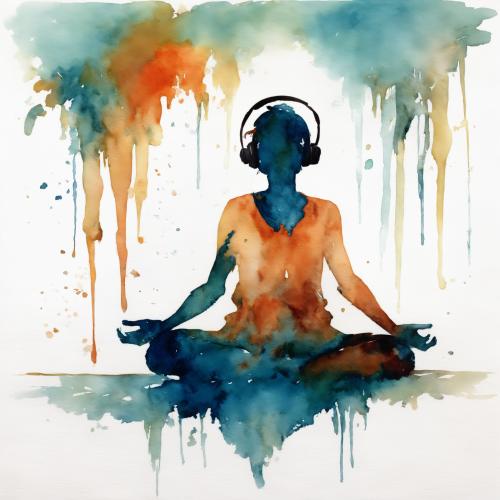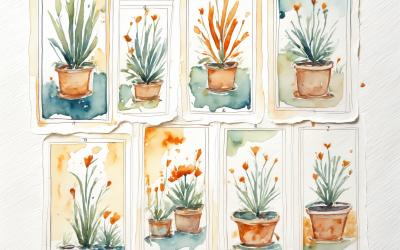If tarot readings sometimes leave you feeling like you've absorbed everyone's emotions within a ten-mile radius, you're not alone. For the highly sensitive among us, tarot can be both a profound gift and an overwhelming challenge. This article explores practical techniques for creating a sustainable tarot practice that honours your sensitivity without draining your emotional resources.
A Personal Note on Sensitivity and ADHD
My own journey with sensitivity and tarot has been a fascinating balancing act. As someone with ADHD, I've discovered that my neurological wiring creates both extraordinary opportunities and notable challenges in my reading practice.
On difficult days, I find myself emotionally drained after just one reading—the intense empathy that allows me to step into my clients' situations and see their challenges from multiple angles can leave me feeling as if I've run an emotional marathon. This is precisely why I've established a firm boundary of never booking more than two client sessions in a single day. Even that can occasionally feel like too much.
Yet this same sensitivity—the ability to hyperfocus on someone else's situation, to rapidly shift between different perspectives, to notice subtle patterns and connections—is exactly what makes the readings valuable. My brain's tendency to approach problems from multiple angles simultaneously helps me offer clients practical, actionable insights rather than vague spiritual platitudes.
It's taken years to recognise that what I initially saw as a liability—the emotional exhaustion, the need for extensive recovery time, the intensity of my reactions to certain cards or situations—is inextricably linked to what makes my readings effective. The sensitivity that requires careful management is the same sensitivity that creates meaningful connection.
If you're a fellow highly sensitive tarot practitioner (whether from ADHD, autism, trauma responses, or natural temperament), I hope this article offers some practical tools for creating a sustainable practice—one that honours your unique perceptual gifts while protecting your energetic resources.
Understanding Sensitivity in All Its Forms
Heightened sensitivity isn't a flaw to overcome—it's a trait that exists across a spectrum, with various origins and expressions. While some people are born with naturally heightened sensory processing (what psychologist Elaine Aron termed Highly Sensitive Persons, or HSPs), others develop increased sensitivity through different paths:
Innate Sensitivity: About 15-20% of people are born with nervous systems that process sensory information more deeply and thoroughly than average. These HSPs often notice subtleties others miss, process information more thoroughly, and can be more emotionally reactive to both positive and negative experiences.
Neurodivergence: Conditions like ADHD and autism often include sensory processing differences. Someone with ADHD might be hypersensitive to rejection and emotional nuance, while autistic individuals frequently experience heightened sensory awareness and can become overwhelmed by stimuli that others filter out automatically.
Trauma Responses: Past trauma can create hypervigilance—a state of constantly scanning for potential threats. This heightened awareness can manifest as sensitivity to others' moods, environmental changes, or symbolic triggers in tarot imagery.
Mental Health Conditions: Anxiety, depression, and other mental health conditions can temporarily or permanently increase sensitivity. The anxious mind, for instance, is often hyperaware of potential negative outcomes and emotional undercurrents.
In tarot practice, these sensitivities might appear as:
- Feeling physically drained after readings
- Absorbing the emotions of clients or friends you read for
- Being overwhelmed by certain card imagery
- Difficulty "switching off" intuitive receptivity
- Physical reactions to energetic shifts during readings
- Needing significant recovery time after intuitive work
Understanding your particular sensitivity pattern is the first step toward creating a sustainable practice. Are you most affected by visual stimuli? Emotional energies? Physical sensations? Tracking these responses can help you develop targeted coping strategies.
Intuition or Something Else? Discerning the Signals
One of the trickiest challenges for sensitive tarot readers is distinguishing between genuine intuitive insights and responses triggered by anxiety, trauma, or projection. When a card prompts a strong reaction, how do you know if you're receiving intuitive guidance or experiencing an emotional trigger?
While there's no foolproof method for differentiation, these questions can help:
- What's the physical sensation? Intuition often manifests as a calm knowing, a gentle "yes" in the body. Anxiety and trauma responses typically come with physical tension, racing heart, shallow breathing, or a sense of urgency.
- Where's the focus? Intuition tends to be clear and specific, while anxiety casts a wide net of "what-ifs" and worst-case scenarios. You might notice a particularly telling pattern when anxiety is at play: a tendency to focus exclusively on the negative aspects of each card. The Tower becomes only about destruction, never about necessary clearing. The Death card becomes literal mortality rather than transformation. The Six of Swords represents only loss, never the journey toward calmer waters.
This doom-focused interpretation is a red flag that fear, not intuition, is driving your reading. True intuition acknowledges challenges but always points toward wisdom and growth potential, even in difficult cards. When you find yourself fixating solely on the worst possible meanings, pause and ask: "What constructive message might this card be offering that I'm currently missing?"
- What's the temperature? Intuitive insights usually feel neutral or warmly confirming—even when the message is challenging. Trauma and anxiety responses often feel hot, electric, or intensely negative.
- Does it expand or contract? Intuition typically creates a sense of opening and expansion, while fear-based responses create contraction and narrowing of perspective.
- Is there a timeframe? Genuine intuition rarely comes with dire deadlines or ultimatums. "You must do this now or else" is usually anxiety speaking, not intuition.
Creating a journal practice around these distinctions can be invaluable. After a reading, record your impressions and physical sensations, then revisit them later to see which proved accurate. Over time, patterns emerge that help you recognise your personal intuitive signature versus reactive responses.
If you consistently struggle with this discernment, consider working with a mental health professional who understands both trauma responses and intuitive practices. They can help you develop personalised techniques for distinguishing between these experiences.
Tarot Cards that Speak to the HSP Experience
Certain cards in the tarot seem to speak directly to the sensitive person's experience. Understanding these cards when they appear in your readings can provide guidance specific to sensitivity challenges:
The Moon represents both the gift and challenge of sensitivity. Its imagery of the unknown path between two towers perfectly captures the uncertainty sensitive people often feel when trying to distinguish between intuition and fear. When this card appears, it might be asking you to trust your perceptions while acknowledging their potential distortions.
The Hermit reminds sensitive people of the necessity of solitude for processing and integration. When this card appears, it might be signalling that you need time alone to sort through absorbed energies and impressions before engaging with others again.
Eight of Cups speaks to the sensitive person's occasional need to walk away from overwhelming situations or relationships—even when they offer certain benefits. This isn't about abandonment but about self-preservation.
Nine of Wands represents the boundaries that sensitive people desperately need but often struggle to maintain. Its appearance might prompt you to examine where your energetic fences need reinforcement.
Four of Swords is the sensitive person's reminder that rest is not optional but essential. Its appearance suggests that mental quiet and physical repose aren't luxuries but necessities for your wellbeing.
The High Priestess represents the gift of sensitivity when it's properly contained and channelled. She sits between two pillars—much like healthy boundaries—allowing her to access deep wisdom without becoming overwhelmed by it.
When these cards appear in readings for yourself, pay special attention. They often carry specific guidance about managing your sensitivity in current circumstances.
Creating a Sensitivity-Friendly Tarot Practice
The environment in which you practice tarot can significantly impact your experience as a sensitive person. Consider these adjustments to create a more supportive setting:
Environmental Considerations:
- Lighting: Soft, natural light is often easier on sensitive nervous systems than harsh overhead lighting.
- Sound: Background noise can be distracting or overwhelming. Consider noise-cancelling headphones or gentle ambient sounds if silence isn't possible.
- Textures: The physical feel of your cards matters. Some sensitive readers prefer linen finishes over glossy ones, or larger cards that require less precise manipulation.
- Scent: Simple essential oils like lavender or frankincense can create an olfactory anchor that helps maintain groundedness during readings.
- Digital vs Physical: While physical cards provide a sensory grounding element, some highly sensitive people find digital readings less energetically demanding. Experiment to discover what works for you.
Timing Considerations:
- Energy Patterns: Track when your sensitivity is heightened or diminished. Many find that early morning readings feel clearer, while evening sessions can tap into deeper but potentially more overwhelming insights.
- Duration Limits: Set a timer for readings to prevent energetic depletion. Even 30 minutes can be too long for some sensitive readers.
- Recovery Periods: Schedule buffer time after readings—especially with others—to process and release absorbed energies.
Energetic Practices:
- Grounding: Before readings, try the "5-4-3-2-1" sensory technique: Notice 5 things you can see, 4 things you can touch, 3 things you can hear, 2 things you can smell, and 1 thing you can taste. This anchors you in physical reality.
- Cleansing: Find cleansing practices that don't overwhelm your senses. Some sensitive people find sage smoke too intense but respond well to sound cleansing with a bell or singing bowl.
- Containment Visualisation: Imagine a protective bubble or shield around you during readings that allows intuitive information in but keeps emotional overwhelm out.
Remember that what works for one sensitive person might overwhelm another. The goal isn't to follow someone else's protocol but to create a personalised practice that supports your specific sensitivity pattern.
Boundary Setting in Readings
For sensitive tarot readers, boundaries aren't selfish—they're survival tools. Here are strategies for maintaining them with both yourself and others:
With Others:
- Session Structures: Create clear beginnings and endings for readings. A simple ritual like lighting a candle to start and extinguishing it to close can help both you and the querent understand when the energetic connection is active versus complete.
- Topic Limitations: Be clear about subjects you won't read on, whether that's health diagnoses, third-party readings, or highly traumatic events that might be triggering.
- Time Boundaries: Use a timer that both you and the querent can see, removing the pressure to extend sessions when your energy is depleted.
- Helpful Scripts: Prepare gentle but firm responses for boundary-crossing requests: "That's beyond the scope of what tarot can ethically address. However, I'd be happy to explore how you're feeling about this situation."
With Yourself:
- Permission to Pause: If a reading becomes overwhelming, give yourself permission to take a break. Simply state, "I need a moment to clarify what I'm seeing," and take a few deep breaths or step away briefly.
- Energetic Separation: Visualise a clear distinction between what belongs to you versus what belongs to the querent. Some readers imagine different coloured energies to help with this discernment.
- Physical Anchors: Keep a grounding object nearby—a stone, crystal, or other item that helps you stay present in your body.
- The Bookmark Technique: If you feel yourself absorbing too much from a client, imagine placing a bookmark in the conversation, closing the book temporarily, and returning to your centred self before continuing.
After Readings:
- Energy Clearing: Find what works for you—washing hands with cold water, stepping outside briefly, or using movement to reset your system.
- Conscious Closure: Explicitly release responsibility for the querent's situation. It can help to say aloud, "This energy belongs to [name]. I'm now returning any energy that isn't mine and reclaiming any energy I've given away."
- Transition Activities: Create a ritual that helps you shift from "reader mode" back to everyday awareness—changing clothes, having a snack, or engaging in a completely different activity.
Remember that boundaries aren't walls—they're filters that allow genuine connection while preventing energetic depletion. With practice, setting and maintaining them becomes more natural and requires less conscious effort.
Tarot Spreads for the Highly Sensitive
These spreads are designed specifically to address the challenges and gifts of heightened sensitivity:
The Overwhelm Assessment Spread (5 cards)
- Current energetic state
- External factors contributing to overwhelm
- Internal factors contributing to overwhelm
- Immediate action for relief
- Longer-term strategy for balance
This spread helps identify the sources of your current overwhelm and provides both immediate and sustainable solutions.
The Boundary Setting Spread (4 cards)
- A boundary I need to establish or strengthen
- What makes this boundary challenging for me
- How to communicate this boundary effectively
- The potential benefit of maintaining this boundary
Use this spread when you feel your energetic borders being crossed but aren't sure how to address the situation.
The Sensitivity Integration Spread (3 cards)
- A sensitivity that feels like a weakness right now
- How this sensitivity is actually a strength
- How to better integrate this aspect of myself
This simple spread helps reframe sensitivity as a gift rather than a burden, particularly useful during times when you're feeling overwhelmed by your perceptions.
The Energy Preservation Spread (6 cards)
- Current energy drains
- Energy sources currently available
- Unnecessary energy expenditures
- Where to direct limited energy resources
- What needs to be released or postponed
- Self-care practice to implement immediately
When you're feeling particularly depleted, this spread can help you allocate your limited energy more effectively.
When to Step Back: Recognizing Your Limits
Sometimes the most sensitive choice is to temporarily step away from tarot practice. Watch for these warning signs that you might need a break:
- Feeling dread before readings
- Experiencing intrusive images or thoughts from past readings
- Physical symptoms that appear consistently after tarot work
- Emotional numbness or excessive detachment
- Sleep disruptions related to readings
- Difficulty maintaining energetic boundaries
- Compassion fatigue or irritability with querents
Creating a personalised "red flag" checklist can help you recognise when you're approaching your limits before you hit complete depletion. This isn't about abandoning your practice but about sustaining it through appropriate rest periods.
If you do need to step back, consider alternative practices that still honour your intuition without the same energetic demands:
- Simple one-card daily draws just for yourself
- Nature-based divination (cloud watching, stone reading)
- Automatic writing with strict time limits
- Movement-based intuitive practices like intuitive dance
- Creating art inspired by your favourite tarot imagery
Remember that temporary withdrawal isn't failure—it's wisdom. Even professional readers and teachers take breaks to replenish their energetic resources.
The Gifts of Sensitivity in Tarot
While this article has focused considerably on managing the challenges of sensitivity, it's equally important to acknowledge its profound gifts in tarot practice:
Depth Perception: Sensitive readers often perceive layers of meaning that others might miss, bringing richness and nuance to interpretations.
Emotional Resonance: Your ability to feel deeply allows you to connect with querents on a profound level, creating space for genuine healing and insight.
Intuitive Accuracy: That subtle "knowing" you experience is often precisely what makes your readings powerful and accurate.
Symbolic Recognition: Sensitive people frequently notice patterns and connections between seemingly unrelated elements, enriching their understanding of card combinations.
Compassionate Presence: Your natural empathy creates a safe container for others to explore vulnerable topics.
These gifts aren't separate from your challenges—they're different sides of the same coin. The very qualities that make tarot overwhelming at times are the same ones that make your practice meaningful and impactful.
Finding Balance: The Middle Path
Creating a sustainable tarot practice as a sensitive person isn't about eliminating sensitivity—it's about finding the middle path between receptivity and protection. Like adjusting the aperture on a camera, you're learning to control how much light enters without blocking it completely.
With thoughtful boundaries, environmental modifications, and self-awareness practices, you can access the gifts of your sensitivity while protecting yourself from its potential overwhelm. This balance isn't achieved once and for all but requires ongoing adjustment as circumstances change.
Remember that sensitivity itself isn't the problem—it's the lack of appropriate containers and boundaries for it. With the right support structures, your sensitivity becomes not a liability but your greatest asset in tarot practice.
By honouring both your perceptiveness and your need for protection, you create a sustainable approach to tarot that serves both you and those you read for. You don't need to choose between your intuitive gifts and your wellbeing—with practice, you can honour both simultaneously, creating a tarot practice that's as nourishing as it is insightful.






